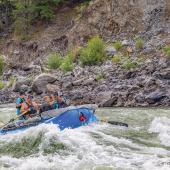Unwelcome Element
Combatting aquatic invasive species.
Southwest Montana’s waterways have long been the backdrop of adventure—some long forgotten, and some so famous that they’re re-enacted for today’s audiences. Known to the Blackfeet as “many-coming-together country,” Bozeman continues to live up to that moniker. People of all stripes followed in the steps of famous explorers, riding the wave of western expansion to promises of adventure, gold, land, and water. Some found their way to a nascent Bozeman and never left. Even now, we’re drawn to the area for strikingly similar reasons.
These days, we aren’t running naked across fields and hiding in the Jefferson like John Colter. Instead, we’re hunting big browns on the Madison and paddling Yankee Jim on the Yellowstone. As southwest Montana continues to boom, humans aren’t the only ones invading. Species native to one area can travel with us, when we move from one place to another. And when we move water from one waterbody to another, we may be spreading aquatic invasive species (AIS), too.
Not all hitchhikers survive, but the ones that do can push out native species in a dramatic underwater aquatic takeover. The plants, animals, and other organisms that prey on native species and their food sources grow and grow and grow, using up available water, food, and space in the process. They turn our favorite waters into un-navigable waterways. They clog municipal water pipes. They bring new diseases that kill wildlife. They’re nasty, they’re expensive, and they wreak havoc on our favorite places. They’re also preventable—by cleaning, draining, and drying our boats and gear.
Water. We play in it, we work in it, we dream about it. We drink it on purpose, we drink it on accident. We chase it. We use it, we abuse it, we celebrate it, we fight over it. Water connects us all, no matter the part it plays in our lives. Bozeman history is forever linked with it. And we’ve connected waterbodies to each other that previously were not. Help protect your waters by preventing the spread of AIS. Clean, drain, and dry your gear.The next time you head out to the river (or lake or creek), make sure your gear is clean of mud, plants, and water. Then make sure no standing water is left hiding in your gear. If you drain your gear, you won’t provide an oasis of moisture in which invasive species can survive. After you’ve cleaned and drained your gear, let it dry however you’d like. Leave your wet gear in the sun. Let the wind dry your boat off as you drive down the highway. Heck, blow dry it if that sounds like fun. The point is, your chances of spreading invasive species are much lower if everything’s dry to the touch.
AIS: By the Numbers
3/4 of Montanans participate in water-related recreation
50% never clean their gear
21% percent of residents unaware of AIS-related water closures in 2016
47% percent of Montanans 18-25 unaware of 2016 closures
Over 120,000 boats inspected in 2021
61 carried quagga/zebra mussels
Over 500 carried aquatic weeds like Eurasian watermilfoil
Zebra mussels and New Zealand mud snails can survive for weeks out of the water
Zero known methods for eradicating quagga/zebra mussels once a water body is infected
Marya Spoja is the fishing & boating program coordinator for the Invasive Species Action Network in Livingston.













